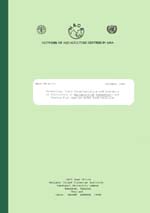
| NACA/WP/86/43 | November 1986 |
 | PRODUCTION, YIELD CHARACTERISTICS AND ECONOMICS OF POLYCULTURE OF MACROBRACHIUM ROSENBERGII AND VARIOUS FISH SPECIES UNDER POND CONDITION 1 |
by
FIRMANSJAH SASTRADIWIRJA 2
Research Conducted under Secondment of Young Scientists Programme
NETWORK OF AQUACULTURE CENTRES IN ASIA
BANGKOK, THAILAND
Hyperlinks to non-FAO Internet sites do not imply any official endorsement of or responsibility for the opinions, ideas, data or products presented at these locations, or guarantee the validity of the information provided. The sole purpose of links to non-FAO sites is to indicate further information available on related topics.
This electronic document has been scanned using optical character recognition (OCR) software. FAO declines all responsibility for any discrepancies that may exist between the present document and its original printed version.
The effect of two densities of freshwater prawn Macrobrachium rosenbergii on production, yield characteristics and economics under polyculture system were examined in four ponds of 1.75 rai each during seven months growing period. Prawns stocked at about 2 (L.D) and 5 (H.D) tails per sq.m with the average weight of 3–4 g. Fish stocked in each ponds are as follows : 225, 500, 350 and 1250 tails per pond for common carp, giant gouramy, bighead and silver carp respectively. The average production of fish in L.D and H.D amounted to 2,295 and 2,125 kg per ha respectively. Common carp had a highest growth, while silver carp and bighead were the lowest. There was an indication that the production in H.D was higher. The average production of prawn in L.D and H.D reached 722 and 910 kg per ha. It is considered that the stocking rate of common carp should be lower, since the pond productivity was not enough to support the growth of silver carp and bighead carp. It is observed that the production of fish was not affected by the different stocking densities of prawn. The survival rate of common carp was the highest (92%), followed by bighead carp (83% and 93%), silver carp (89% and 80%) and giant gouramy (76% and 73%). For the prawn it ranged from 49.1–61.1%, except one replicate in L.D which comprised 95%. This may probably be due to second restocking. The F.C.R of fish, based on the F.C.R of prawn (2.5), were 0.85 and 1.12 respectively in L.D and H.D.
The average weight (g) of male prawn ranged widely in each category (43–102 g) compared to female prawn (29–51 g). The percentage in number of female prawn ranged 65–72% in both L.D and H.D. There is a positive relationship between stocking density and the percentage both in number ans weight of female prawn as well as the marketable yield. The marketable yield comprised about 87% of total biomass both in L.D and H.D.
There was no extreme fluctuations of water quality parameters during culturing period, as well as the algal blooms.
Feed was the major item among the operating cost, which comprised 44 to 48%, followed by the prawn and fish cost ranging from 21–27%. The cost production per kg of prawn and fish altogether amounted 25 baht and 31 baht respectively for L.D and H.D. The profit per pond in H.D was higher, however, the profit per kg were the same both in L.D and H.D. The rate of return either on operating cost or initial capital cost was considered high. Thus, we may conclude that at this farm size, polyculture of prawn and fish is such profitable.